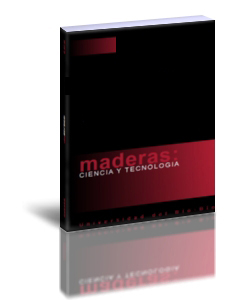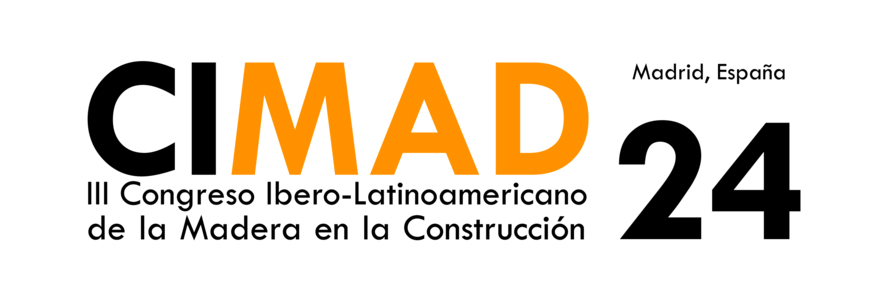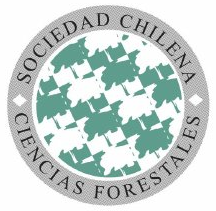The effect of cutting direction and water based varnish type on sound absorption coefficient in some native wood species
DOI:
https://doi.org/10.22320/s0718221x/2025.09Keywords:
Aqueous varnish, acoustic properties, Fagus orientalis, noise, Pinus sylvestris, sound absorption coefficientAbstract
Noise which could be defined as disturbing sound, is becoming a major problem depending with developing technology. Controlling the noise helps raising the quality of life to higher levels. Although the intensity of the noise is not at a level that will affect human health, it should be reduced or eliminated, for better life standart. Due to the adverse effects of the noise level on health; the acoustic properties of living areas require serious consideration. Sound absorption coefficients of the materials used in the interior play an important role in providing sensory comfort depending on the volume. Natural and artificial wood are commonly used materials in interior design, especially in the construction of partition elements. In addition, wood is natural material and it has some important advantages and disadvantages. In this study the sound absorption coefficients of eastern beech and scotch pine trees, which are the most preferred materials in interior design, were investigated. For this pupose, these wood materials were cut superficially and radially according to the intersection directions, then the sample surfaces were varnished with one and two component water-based varnishes that do not contain solvent-based resin. The sound absorption coefficients of the obtained samples were determined by the impedance tube method and the results were compared statistically. It has been investigated that the obtained results could be evaluated statistically within the frequency values, besides, different results could be obtained according to the characteristics of natural wood materials, the direction of intersection and water-based varnish types. According to the findings obtained as a result of the study, it has been suggested that if natural wood material is used indoors, the superficial cross-section of East beech wood should be used according to the direction of intersection, and a two-component varnish should be used according to the varnish type.
Downloads
References
Akdağ, N. 1999. Measures Required for Sound Pass Loss and Noise Control in Doors. Istanbul University Publication. Turkish Chamber of Mechanical Engineers Insulation Congress. 11-12 February. Publication 213. pp. 53-64, Istanbul, Turkey.
Akdağ, N.Y. 2001. Evaluation of Interior Walls in terms of Sound Insulation. In: Turkish Chamber of Mechanical Engineers Chamber of Mechanical Engineers Insulation Congress. 23-25 March. pp. 108-114. Istanbul, Turkey
ASTM. 1983. Wood to be Used as Panels in Weathering Tests of Coatings. ASTM D358. 1983. American Society for Testing and Materials, pp. 1-3.
ASTM. 1991. Standart Specification for Standard Environment for Conditioning and Testing Point Varnish Lacquer and Related Materials. ASTM D3924. 1991. American Society for Testing and Materials, pp. 1-3.
ASTM. 1998. Standart Practice for Determination of Resistance of Factory Applied Coatings on Wood Products of Stain and Reagents. ASTM D3023. 1998. American Society for Testing and Materials: USA.
Ayan, S. 2012. Determination of acoustical properties of heat treated laminated wooden panels. PhD The- sis. Gazi University. 179p.
Babalık, F. 2003. Noise at work and the possibility of deafness. In. Proceedings of II. Occupational Health and Safety Congress/ISG-01. Adana, Turkey. 2-3 May 2003.
Berkel, A. 1970. Wood Material Technology. Istanbul University Faculty of Forestry Publications. Istan- bul University Publication Number 1448. Istanbul, Turkey.
BRÜEL & KJAER. 2024. Bruel Kjaer Transmission Loss Tube Kit (50Hz - 6.4 kHz) - Type 4206. https://www.bksv.com/media/doc/bp1039.pdf
Belgin, E.; Çalışkan, M. 2004. Protection of Noise and Hearing in Working Life. Turkish Medical As- sociation Publications. Ankara, Turkey. pp.17-44. ISBN 975-6984-65-1 https://www.ttb.org.tr/kutuphane/isak_gurultu_kitap.pdf
Chung, H.; Park, Y.; Yang, S.Y.; Kim, H.; Han, Y.; Chang, Y.; Yeo, H. 2017. Effect of heat treatment temperature and time on sound absorption coefficient of Larix kaempferi wood. Journal Wood Science 63: 575–579. https://doi.org/10.1007/s10086-017-1662-z
Choe, H.; Sung, G.; Kim, J.H. 2018. Chemical treatment of wood fibers to enhance the sound absorption coefficient of flexible polyurethane composite foams. Composites Science and Technology 156: 19-27. https://doi.org/10.1016/j.compscitech.2017.12.024.
Ersoy, S. 2001. Investigation of Sound Absorption Properties of Industrial Tea-Lubber-Fiber Wastes. Master Thesis. Marmara University. 55p.
Gürtekin, A.; Oğuz, M. 2002. Furniture and Decoration Material Knowledge. National Education Press: Istanbul, Turkey. pp. 15-16. ISBN 975-11-221-7.
Kolya, H.; Chun-Won, K. 2021. Hygrothermal treated paulownia hardwood reveals enhanced sound absorption coefficient: An effective and facile approach. Applied Acoustics 174. e107758. https://doi.org/10.1016/j.apacoust.2020.107758
ISO.2004. Acoustics Determination of Sound Absorption coefficient And Impedance or Admittance By The Impedance Tube Method. ISO/DIS10534. 2004. International Standard Organization: Switzerland.
Johnson, R. (1997). Waterborne coatings-An overview of waterborne coatings: A formulator’s perspective. Journal of Coatings Technology 69(864): 117-121.
Kaya, A. İ.; Dalgar, T. 2017. Acoustic Properties of Natural Fibers in Terms of Sound Insula- tion. Journal of Mehmet Akif Ersoy University Institute of Science and Technology 8(Special 1): 25-37. http://dergipark.ulakbim.gov.tr/makufebed
Keskin, O.; Yılmaz, S. 2020. Parameters Affecting Sound Absorption Performance in Gourd Fiber (Luffa Cylindrica)-Epoxy Composite. Süleyman Demirel University, Journal of Natural and Applied Sciences 24(1): 201-208. https://doi.org/10.19113/sdufenbed.681607
Kayılı, M. 1981. Increasing the Sound Transmission Loss of Lightweight Partition Elements with the Addition of Helmholtz Resonators. PhD thesis. Istanbul Technical University Faculty of Architecture. 98p.
Örs, Y.; Keskin, H. 2001. Wood Material Knowledge. Publication 2. pp. 159-163. ISBN 975-6574-01-1
Özgüven, N. 2008. Noise Control- Industrial and Environmental Noise. Turkish Acoustic Association Technical Publications. 2nd Edition. 124p. ISBN:978-605-89991-0-7. https://takder.org/?p=1979.
Özkan, S. 2001. Sound Insulation Applications. In. Turkish Chamber of Mechanical Engineers Insulation Congress. 23-25 March. pp. 114-120. Eskişehir, Turkey Publication Number: E/2001/264. https://www.mmo.org.tr/books/insulation2001congressandexhibitionproceedingsbook.
Sönmez, A.; Budakçı, M. 2004. Top Surface Treatments in Woodworking II, Protective Layer and Paint / Varnish Systems. Gazi University Faculty of Technical Education.: Ankara, Turkey p. 34-48. ISBN: 975- 97281-0-9 (TK), 975-97281-1-7 (2.C.)
Sönmez, A.; Budakçı M.; Yakın, M. 2004. The Effects of Water Solvent Varnish Applications on Wood Material on Hardness, Gloss and Adhesion Resistance. Gazi University Journal of Polytechnic 7(3): 229-235. Ankara, Turkey. https://dergipark.org.tr/en/pub/politeknik/issue/33010/366972
TS ISO 3129. Wood - Sampling methods and general requirements for physical and mechanical testing of small clear wood specimens. Turkish Standardization Institute: Ankara, Turkey.
TS (1976) 2471. Determination of Moisture Amount for Physical and Mechanical Experiments in Wood. TS 2471. 1976. Turkish Standardization Institute: Ankara, Turkey. pp. 1-2.
Tudor, E.M.; Dettendorfer, A.; Kain, G.; Barbu, M.C.; Reh, R.; Krišťák, Ľ. 2020. Sound-Absorption Coefficient of Bark-Based Insulation Panels. Polymers 12(5). e1012. https://doi.org/10.3390/polym12051012
Yang, H.S.; Kim, D.J.; Kim, H.J. 2003. Rice Straw-Wood Particle Composite for Sound Absorbing Wooden Construction Materials. Bioresource Technology 86: 117-121. https://doi.org/10.1016/S0960-8524(02)00163-3
Downloads
Published
How to Cite
Issue
Section
License

This work is licensed under a Creative Commons Attribution 4.0 International License.
Los autores/as conservarán sus derechos de autor y garantizarán a la revista el derecho de primera publicación de su obra, el cuál estará simultáneamente sujeto a la Licencia de Reconocimiento de Creative Commons CC-BY que permite a terceros compartir la obra siempre que se indique su autor y su primera publicación esta revista.




































